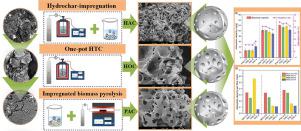Resources, Conservation and Recycling ( IF 13.2 ) Pub Date : 2020-11-06 , DOI: 10.1016/j.resconrec.2020.105254 Ziyun Liu , Zihan Wang , Shuai Tang , Zhidan Liu

|
Biochar can be fabricated from waste biomass via thermochemical conversion. Here we investigated the production of activated biochar from cow manure via three different approaches, i.e., hydrochar-impregnation (HAC), impregnated biomass pyrolysis (PAC) and one-pot hydrothermal carbonization (HOC). The surface area of HAC, HOC and PAC increased from 81.00, 307.06 and 333.03 m2/g to 637.75, 791.20 and 841.91 m2/g, respectively, with the increased addition ratio of ZnCl2 to biomass/ biochar (0.5:1~4:1). HOC had significantly superior performance in the surface area, porosity and aromatization degree to HAC, whereas it had similar porosity and surface functional groups, but slightly different surface morphology to PAC. Specifically, HOC and PAC were characterized with higher amounts of surface functional groups including carboxyl –COOH and phenolic –OH, whereas HAC was detected with more C–O bond. HOC gained a highest degree of aromatization with a maximum sorption capacity of 102.72 mg phenol/g, which was in between HAC (42.12 mg/g) and PAC (125.70 mg/g). The study on phenol sorption revealed that not only surface functional groups but also porosity played critical roles in pollutant sorption. The well-fitted PSO kinetic model further verified that the sorption using HOC and PAC was involved with chemical and physical processes, whereas the sorption using HAC was accompanied with higher chemisorption and lower physical sorption due to its ample surface groups but poor porosity. In addition, energy analysis revealed that HOC is a simple-operation and energy-effective process to prepare activated biochar in comparison to HAC and PAC.
中文翻译:

通过三种不同方法从牲畜粪便中制备活性炭的特性,吸附特性
生物炭可以通过热化学转化由废物生物质制成。在这里,我们研究了通过三种不同的方法从牛粪中生产活化的生物炭的方法,即碳氢化合物浸渍(HAC),生物质热解浸渍(PAC)和一锅热液碳化(HOC)。HAC,110C和PAC的表面积从81.00增加,307.06和333.03米2 / g至637.75,791.20和841.91米2分别/ g时,与氯化锌的增加的添加比例2到生物质/生物炭(0.5:1〜4:1)。HOC在表面积,孔隙率和芳构化度方面显着优于HAC,而其孔隙率和表面官能团相似,但与PAC的表面形态略有不同。特别是,HOC和PAC具有较高的表面官能团(包括羧基-COOH和酚类-OH),而HAC具有更多的C-O键。HOC的芳构化程度最高,最大吸附量为102.72 mg苯酚/ g,介于HAC(42.12 mg / g)和PAC(125.70 mg / g)之间。苯酚吸附的研究表明,不仅表面官能团而且孔隙率在污染物吸附中也起着关键作用。拟合良好的PSO动力学模型进一步证明,使用HOC和PAC进行的吸附与化学和物理过程有关,而使用HAC进行的吸附则具有较高的化学吸附性和较低的物理吸附性,这是因为其表面基团丰富但孔隙率差。此外,能量分析表明,与HAC和PAC相比,HOC是制备活化生物炭的简单操作且节能的过程。


























 京公网安备 11010802027423号
京公网安备 11010802027423号